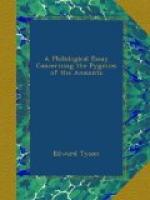passynge old. Theise men ben the beste worcheres
of gold, sylver, cotoun, sylk, and of alle such thinges,
of ony other, that be in the world. And thei han
often tymes werre with the briddes of the contree,
that thei taken and eten. This litylle folk nouther
labouren in londes ne in vynes. But thei han grete
men amonges hem, of oure stature, that tylen the lond,
and labouren amonges the vynes for hem. And of
the men of oure stature, han thei als grete skorne
and wondre, as we wolde have among us of Geauntes,
zif thei weren amonges us. There is a gode cytee,
amonges othere, where there is duellynge gret plentee
of the lytylle folk, and is a gret cytee and a fair,
and the men ben grete that duellen amonges hem; but
whan thei getten ony children, thei ben als litylle
as the Pygmeyes, and therefore thei ben alle, for
the moste part, alle Pygmeyes, for the nature of the
land is suche. The great Cane let kepe this cytee
fulle wel, for it is his. And alle be it, that
the Pygmeyes ben litylle, zit thei ben fulle resonable,
aftre here age and connen bothen wytt and gode and
malice now.” This passage, as will be noted,
incorporates the Homeric tale of the battles between
the Pigmies and the Cranes, and is adorned with a representation
of such an encounter. Whether Maundeville’s
dwarfs were the same as the Siao-Jin of the Shan-hai-King
is a question difficult to decide; but, in any case,
both these pigmy races of legend inhabited a part of
what is now the Chinese Empire. The same Pigmies
seem to be alluded to in the rubric of the Catalan
map of the world in the National Library of Paris,
the date of which is A.D. 1375. “Here (N.W.
of Catayo-Cathay) grow little men who are but five
palms in height, and though they be little, and not
fit for weighty matters, yet they be brave and clever
at weaving and keeping cattle.” If such
an explanation may be hazarded, we may perhaps go further
and suppose that Paulus Jovius may have been alluding
to the Koro-puk-guru, when, as Pomponius Mela tells
us, he taught that there were Pigmies beyond Japan.
In both these cases, however, it is well to remember
that there is a river in Macedon as well as in Monmouth,
and that it is hazardous to come to too definite a
belief as to the exact location of the Pigmies of
ancient writers.
[Footnote A: Maundeville, p. 211.]
[Footnote B: Quart. Rev., 172, p.
431.]
The continent of Africa yielded its share of Pigmies
to the same writers. The most celebrated of all
are those alluded to by Aristotle in his classical
passage, “They (the Cranes) come out of Scythia
to the Lakes above Egypt whence the Nile flows.
This is the place whereabouts the Pigmies dwell.
For this is no fable but a truth. Both they and
the horses, as ’tis said, are of a small kind.
They are Troglodytes and live in caves.”
Leaving aside the crane part of the tale, which it
has been suggested may really have referred to ostriches,
Aristotle’s Pigmy race may, from their situation,
be fairly identified with the Akkas described by Stanley
and others. That this race is an exceedingly
ancient one is proved by the fact that Marriette Bey
has discovered on a tomb of the ancient Empire of Egypt
a figure of a dwarf with the name Akka inscribed by
it. This race is also supposed to have been that
which, alluded to by Homer, has become confused with
other dwarf tribes in different parts of the world.




